
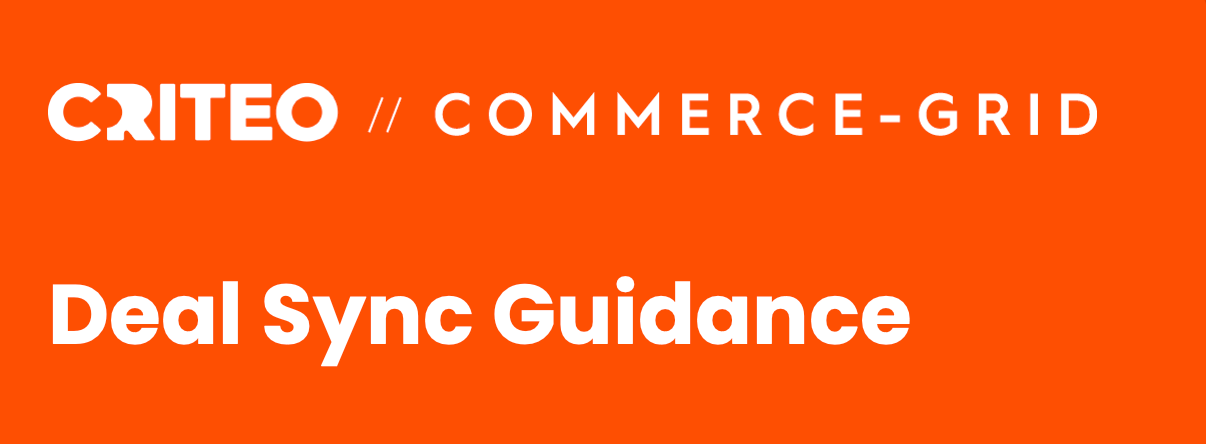
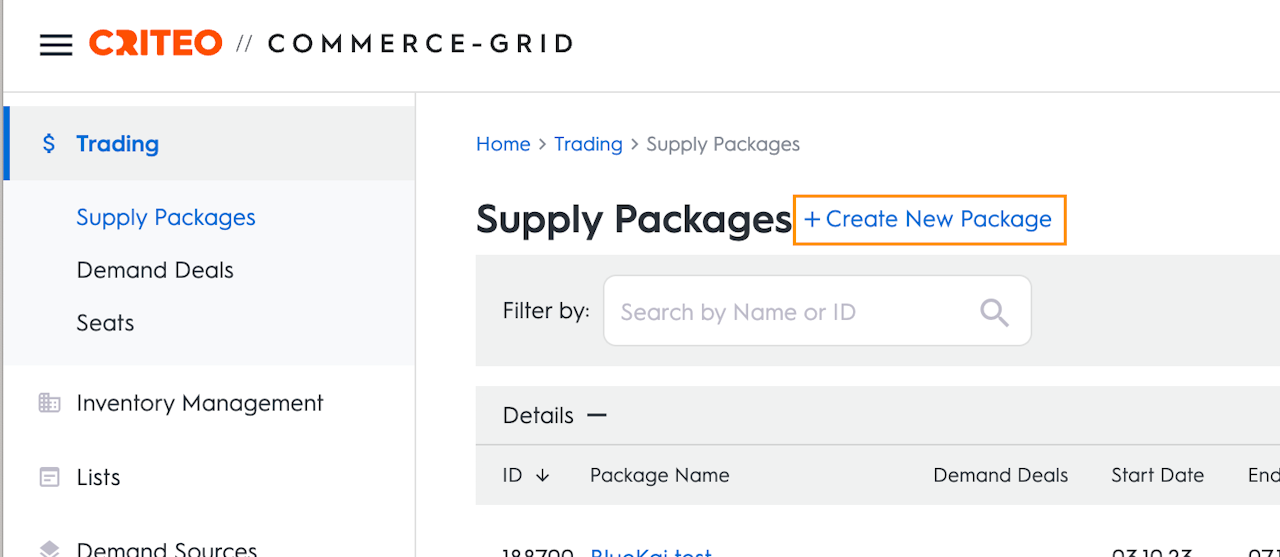

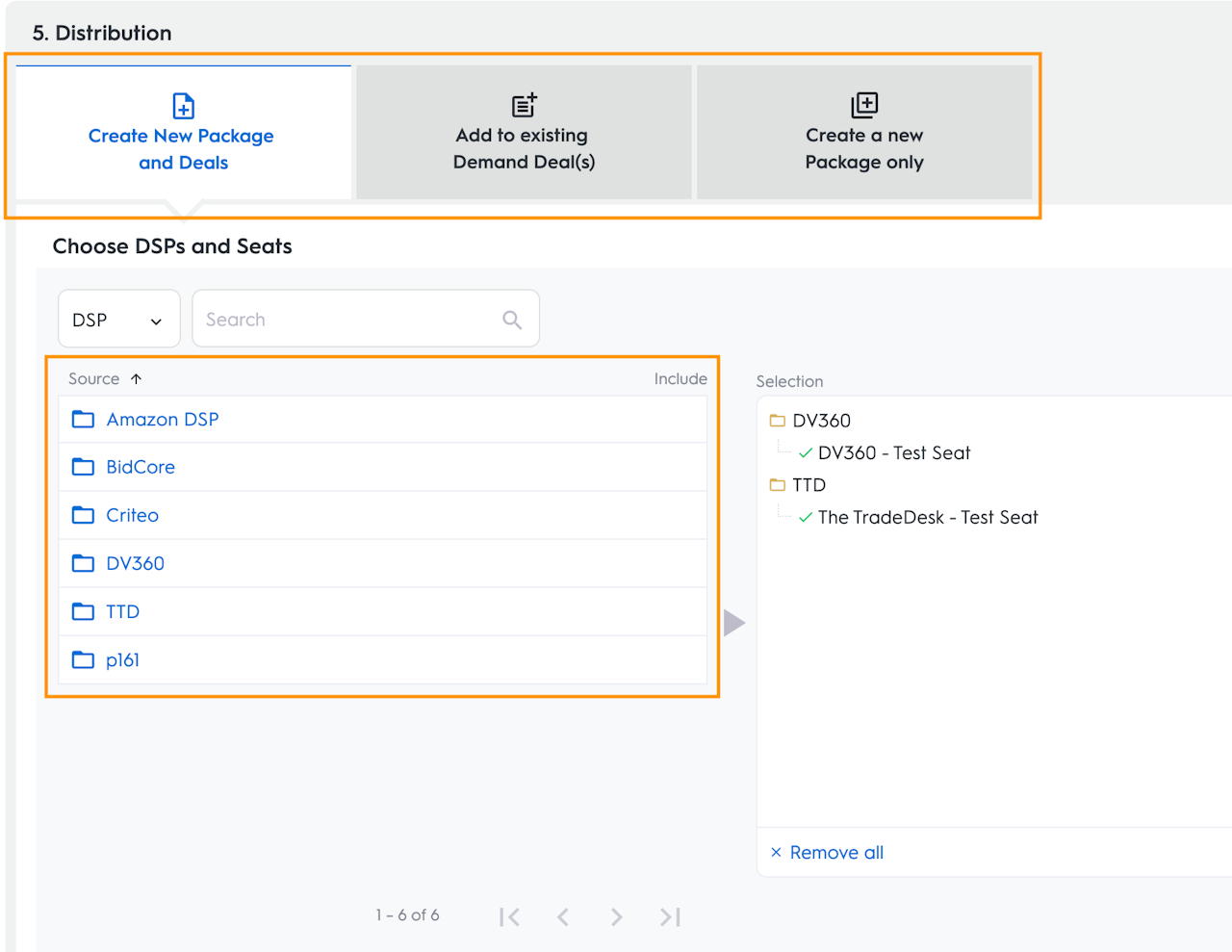
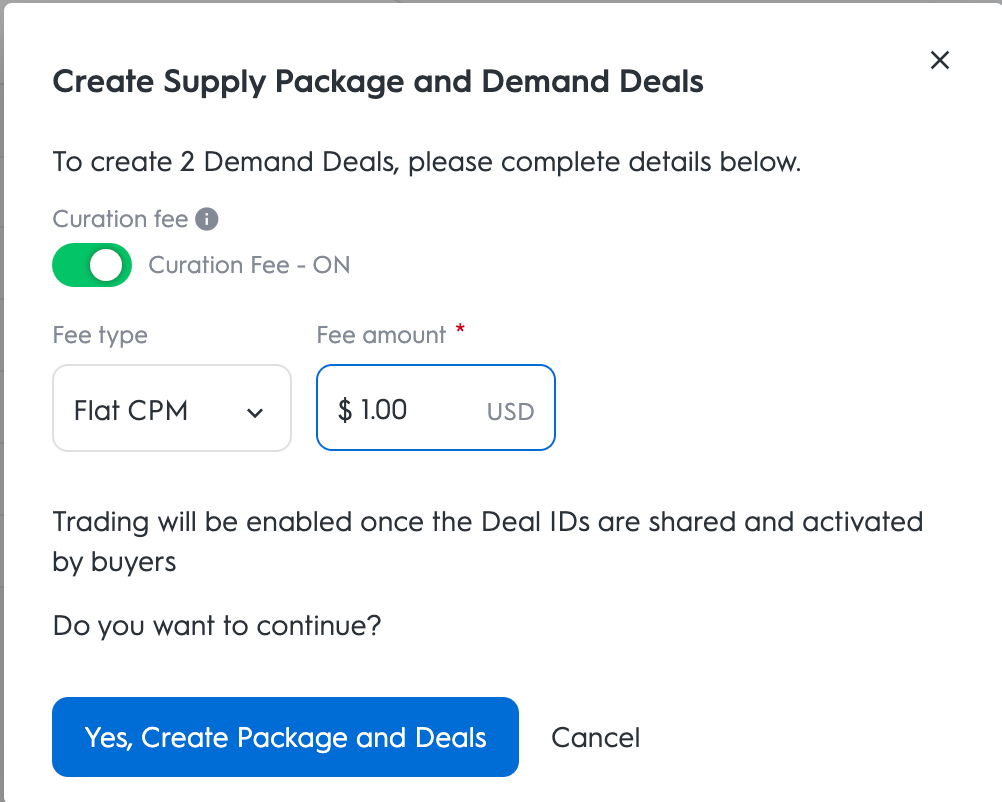
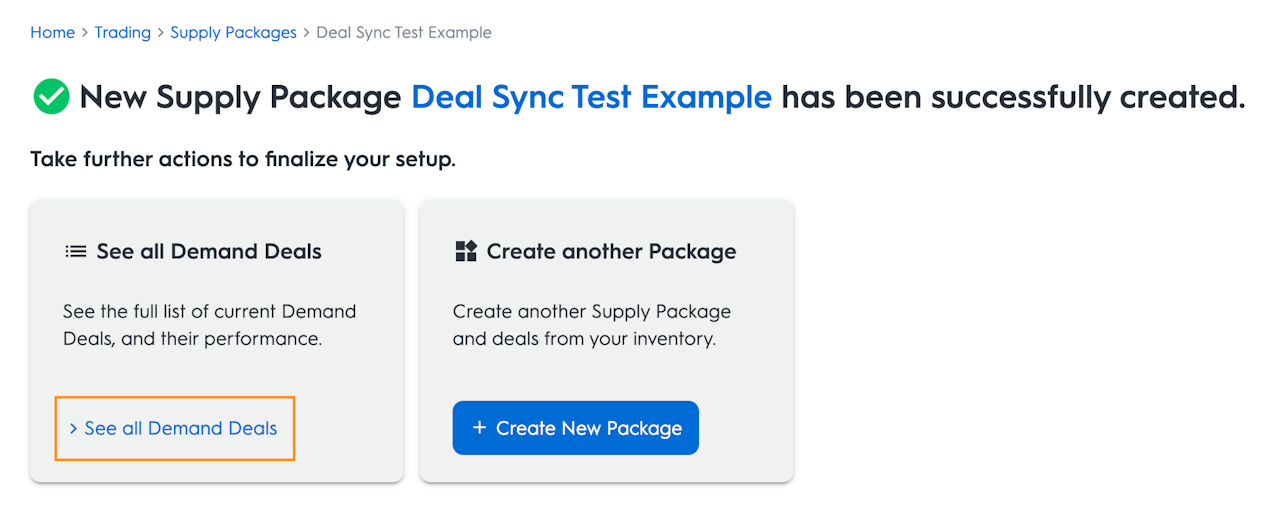
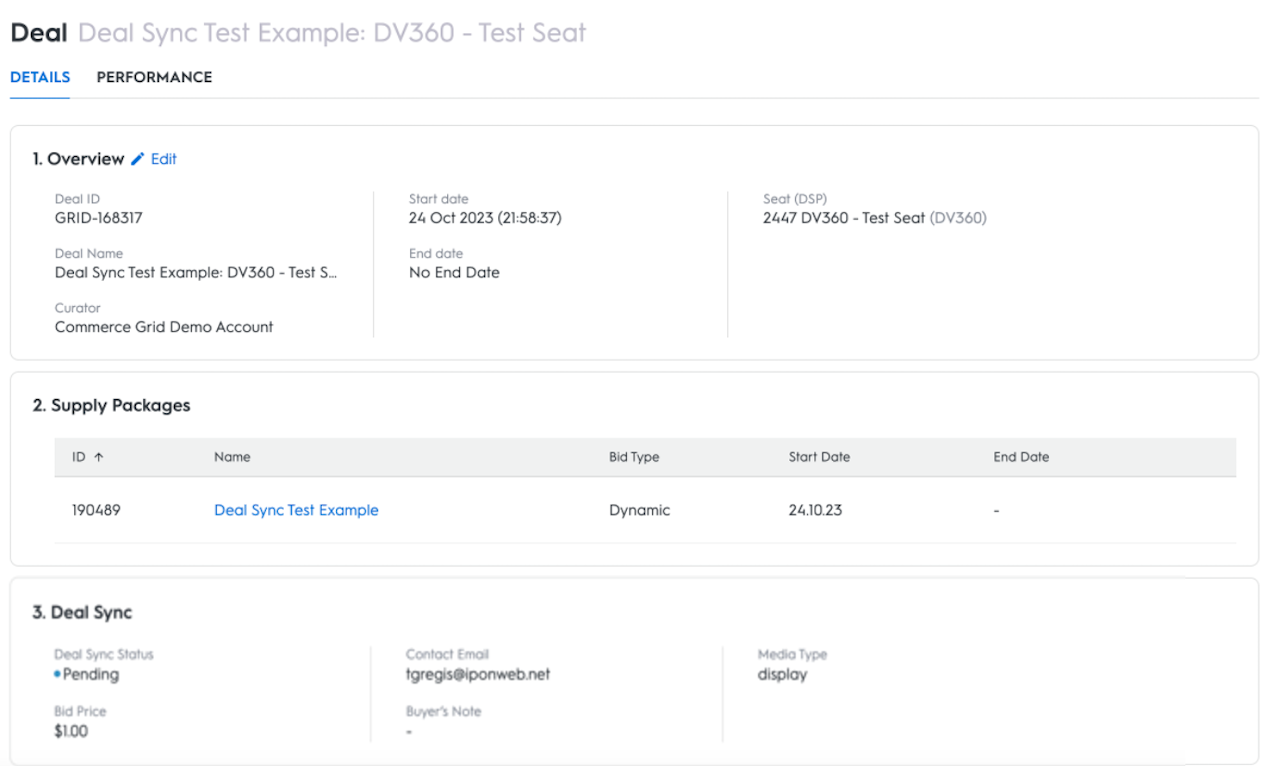



Deal Sync Overview
SUMMARY
Deal Sync is an API service from Commerce Grid’s intermediary partner BidSwitch. The Deal Sync API facilitates automated delivery of Deal IDs into compatible DSPs (currently DV360 and The Trade Desk), without the need for deal creators working in CGrid to manually email them to buy-side partners.
Deal Sync is available to all publishers leveraging Commerce Grid's deal packaging capabilities.
THE VALUE OF DEAL SYNC TO PUBLISHERS & THEIR BUYING PARTNERS
Historically, the only way for a publisher working in Commerce Grid to deliver deals to a deal buyer was to copy a deal ID and manually email it to the buyer. This manual workflow presents several, less-than-ideal scenarios for both parties, including:
The opportunity for human errors that result in an incorrect deal ID implementation on the demand side;
Additional time required to setup deals, or to setup campaign line items for buyers;
Presents management challenges to publishers who are working with dozens, or even hundreds of buyers.
Deal Sync solves these shared challenges by offering an integrated solution that automatically synchronizes deal setup between Commerce Grid and a compatible DSP, surfacing deal IDs and setup parameters for a deal quickly and easily, directly within a buyer's native workflow.
Some DSPs have even begun to require synchronized deal setup, as the automated process significantly reduces errors.
HOW DEAL SYNC WORKS
Here is the data flow between Commerce Grid, the Deal Sync API, and a DSP(s), when Deal Sync is used:
A publisher working in Commerce Grid creates a Supply Package and subsequent Demand Deal and then selects a Deal Sync-enabled DSP for distribution which automatically triggers the Deal Sync process.
The deal information is retrieved from Commerce Grid by Bidswitch.
BidSwitch reviews and validates the deal information.
After validation, BidSwitch delivers the deal to the selected DSP(s).
The DSP receives and surfaces deal information in a deal negotiation interface.
The buyer navigates to the deal negotiation interface in the DSP, and accepts the deal.
Acceptance in the DSP automatically triggers a call to BidSwitch, relaying the acceptance notification.
BidSwitch calls Commerce Grid, which surfaces the deal acceptance information for publishers within the UI.

Deal Sync Guidance & Guardrails
ENABLED DSPs
Deal Sync is available to a limited number of integrated DSP partners.
These partners include:
DV360
Click here for the DV360 activation guide, which provides buyers with information about how to activate Deal Synced deals within their DSPs
The Trade Desk
Click here for the TTD activation guide, which provides buyers with information about how to activate Deal Synced deals within their DSPs
DSP SYNCHRONIZATION TIMES
Each DSP has a unique synchronization process, resulting in varying time to activation for each Deal Sync-enabled DSP.
These times include:
DV360
One hour after deal creation for a deal to surface in the DV360 UI
The Trade Desk
Three hours after deal creation for a deal to surface in the TTD UI
If you have a buying partner who requires immediate deal activation, please manually deliver the deal ID to your buying partner to circumvent any delay caused by Deal Sync.
SUPPORTED MEDIA FORMATS
Not every inventory type is supported by Deal Sync. Currently, Display and Video formats are supported. Native Inventory is not supported on Deal Sync.
If you have built a deal that contains Native inventory, it will need to be distributed to buying partners manually via email.
EDITING A DEAL AFTER SYNCHRONIZATION
Given that Deal Sync is an automated synchronization process, using it limits the edits that can be made to a deal after the deal has been created and the syncing process has begun.
Below are the edits that can and cannot be made after a Demand Deal has been synced:
Edits that can be made after synchronization:
Curation fee amount can be adjusted
Additional Supply Packages can be grouped into a synced demand deal
Edits that cannot be made after synchronization:
Setting a new bid price for the synced deal
Deleting an existing Supply Package that is associated with the synced demand deal
Changing the inventory type of the Supply Package associated with the synced deal
In most cases, we recommend creating a new Demand Deal, and redistributing the deal to buying partners if you have significant edits you must make to it.

Step 1: Create a New Supply Package
To get started with Deal Sync, navigate to the Trading tab, and select Supply Packages.
Next, click "Create New Package"

Step 2: Build your Supply Package
Build your Supply Package with all of your desired inventory assignment and targeting parameters.
Note that if you select the "Native" media type under the Categories section of the Supply Packages workflow, you will not be able to use Deal Sync.

Step 3: Select Distribution Details
As the final step of the Supply Package workflow, you will be asked to indicate:
If you'd like to automatically create Demand Deals when you generate the Supply Package, and
Which DSPs you would like to distribute to.
When selecting whether or not you'd like to automatically create Demand Deals, please note that, to leverage Deal Sync, you must either select "Create New Package and Deals" or "Add to existing Demand Deal(s)".
The former will allow you to create an all new package and associated Demand Deal(s), while the latter will allow you to add your new Supply Package to an existing Demand Deal. Even if you have an existing Demand Deal that is Deal Sync enabled, you will be able to add a new Supply Package to it.
When selecting which DSP(s) you'd like to distribute to, please note that DV360 and TTD are the only Deal Sync-enabled partners at this time.
If you choose other DSP partners besides DV360 and TTD, your deals to DV360 and TTD WILL use Deal Sync, but your deals to other DSPs will NOT use Deal Sync, and will require you to manually email deal IDs to buying partners. You are able to distribute to as many DSPs as you choose.
After making your selections, click the "Create" button at the bottom of the page. This action will initiate Deal Sync.

Step 4: Validate your Demand Deal Parameters
After clicking "Create" a prompt will require validation of the Demand Deals before they are automatically created.
Ensure your desired choices are made here, as the Demand Deals will be automatically created after clicking "Yes, Create Package and Deals"
Note: You will be asked to include an email. This is the email where updates about your Demand Deal's sync status will be delivered.

Step 5: View your Demand Deals
After validating your Demand Deal parameters, you will be offered the option to create a new package, or view the Demand Deals you just created.
Click "See all Demand Deals" to be directed to your newly created deals, and to continue the Deal Sync workflow.

Step 6: Monitor your Deal Acceptance Status
You will be redirected back to the Demand Deals section, where you will have several opportunities to monitor the status of your Deal Synced deal, and your buying partner's acceptance of the deal:
On the Demand Deals page
On the Demand Deals page, you will notice an additional column called "Deal Sync". This allows you to quickly and easily see the status of your synced deal, across all of your open Demand Deals.
Within a specific Demand Deal
You will also be able to click on a Demand Deal and view the Deal Sync details of it's Deal Sync status by scrolling down to Step 3. "Deal Sync". Here, you will see:
The status of the deal (see below for status options)
The email associated with the synced deal for communications updates
The bid price of the deal
The inventory type of the deal
Buyers notes. DSPs will offer buyers an opportunity to include a note back to you when they accept the deal, you will receive those notes here.
Via your email
In addition to receiving updates of the Deal Sync status in the UI, you will also be forwarded automatic updates to the email address you indicated during the Demand Deal setup.
POSSIBLE DEAL SYNC STATUSES

Deal Sync FAQ
DEAL SYNC FAQ
Which DSPs support Deal Sync?
Today, Google DV360 and The Trade Desk are the DSPs that support Deal Sync. When selecting these DSPs for deal distribution in the Supply Packages and Demand Deal workflow, Deal Sync will automatically be activated.
Are all media types supported by Deal Sync?
Currently, Native is not supported by Deal Sync. If your Demand Deal includes Native inventory, please distribute the Deal ID to buying partners working in DV360 and TTD manually.
Am I able to make changes to a Demand Deal after it’s been Deal Synced?
We recommend making minimal changes to a Demand Deal after it has been synced. Here’s whats possible in terms of edits that can be made once a deal has been created and synced:
Curation fee amount can be changed
A new Supply Package can be added to the Demand Deal (however any Supply Packages already associated to the synced Demand Deal cannot be removed)
If you have edits you’d like to make to your Demand Deal outside of these parameters (setting a new bid price, changing inventory types, etc), please create a new Demand Deal with your adjusted parameters, and redistribute it to your buying partners using Deal Sync once again.
I’ve distributed a deal via Deal Sync, and my buying partner cannot find it. Help!
Please follow these steps to support your buying partner in locating the correct deal:
Share our DSP activation guides with your contact. The DV360 Guide can be found here, and the TTD guide can be found here.
Confirm that your contact is searching for the correct deal name in their DSP
Deal Sync is not an instant process. Confirm that enough time has passed from when the deal was created. Synchronization times are as follows:
For DV360: 1 hour
For TTD: 3 hours
Can API users use deal sync?
Yes, Deal Sync is available to users who are leveraging CGrid’s API for Demand Deal creations. Please refer to the API documentation for more information.
I’m a Curator who has been working in The MediaGrid’s Curation UI, and am now moving to the CGrid UI. What will happen with the deals I created in the Curation UI?
All deals that were already activated with DSPs (via deal sync or not) will continue to operate, and will be exposed to you in the CGrid UI. Please note that the deal creation workflow has been simplified in the CGrid UI; instead of the Supply Deal > Supply Package > Demand Deal workflow present in the TMG platform, CGrid will only leverage Supply Packages > Demand Deals to build a deal.

Troubleshooting Deal Sync
TROUBLESHOOTING DEAL SYNC
Please refer to the steps below to troubleshoot issues with syncing a Demand Deal:
Check the parameters of your deal
Remember, Deal Sync is only available with DV360 and TTD, ensure that your Demand Deals are pointed to these DSPs if you intend to leverage Deal Sync.
Native media type is not available via Deal Sync. If you have included it, Deal Sync will not work. Please start the Supply Package/Demand Deal creation process again, without Native media type included.
Reach out to the buyer to troubleshoot
Even with the automation provided by Deal Sync, there are still several variables that can occur on the buyer's side, which may make it hard to locate the deal. Ensure that you check the buyer:
Is searching for the right deal name/searching for deals delivered from BidSwitch/Commerce Grid
Has clicked “accept” after finding the deal
Has waited long enough for the deal to properly sync - see the table on synchronization times in the "Guidance & Guardrails section of this guide.
Reach out to your Commerce Grid support team
Your Commerce Grid team will be able to support you further in troubleshooting by checking the BidSwitch API to confirm the status of your deal in a more real-time manner.
